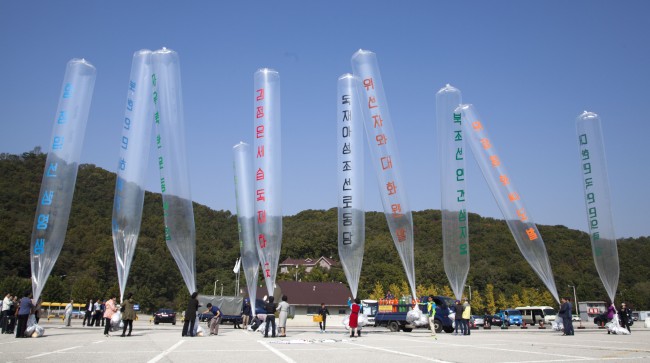by HYUNG-JIN KIM, Associated Press
SEOUL, South Korea (AP) — South Korean activists vowed Thursday to launch balloons next week carrying anti-Pyongyang leaflets across the border into North Korea, days after their campaign triggered gunfire between the rival Koreas.
North Korea considers leaflets an attack on its government and has long demanded that South Korea ban activists from sending them. South Korea refuses, saying the activists are exercising freedom of speech.
Last Friday, North Korea opened fire after propaganda balloons were floated from the South. South Korean soldiers returned fire, but there were no reports of casualties. North Korea has warned it would take unspecified stronger measures if leafleting continues.
South Korean activist Choi Woo-won said Thursday his group won’t yield to the North’s threats and plans to send about 50,000 leaflets on Oct. 25.
“Our government and people must not be fazed even though North Korea, the criminal organization, is blackmailing us,” said Choi, a university professor.
He said his leaflets will urge a military rebellion against North Korean leader Kim Jong Un. “The leaflets will tell North Korean soldiers to level their guns at Kim Jong Un, launch strikes at him and kill him,” Choi said.
Another activist Lee Min-bok said he was also ready to fly millions of leaflets, which describe South Korea’seconomic prosperity and urges North Koreans to flee, as soon as weather conditions such as wind direction are favorable.
“No one can block my rights [to send leaflets],” said Lee, whose leafleting Friday from a South Korean border village was believed to have directly caused North Korea to start firing.
The leafleting was high on the agenda when military generals from the two Koreas met in a border village on Wednesday in the countries’ first military talks since early 2011. During the meeting, North Korea requested again that South Korea prevent leafleting, but South Korea said it could not comply, according to Seoul’s Defense Ministry.
Friday’s shootout came three days after navy ships of the two Koreas exchanged gunfire near their disputed western sea boundary, the scene of several bloody naval skirmishes between the countries in recent years.
South Korean military officials earlier described the Oct. 7 shootout as an exchange of warning shots. But they later revealed at least one of three South Korean navy ships involved aimed to destroy a North Korean ship but failed because of a mechanical problem in its artillery guns.
The shootout happened because the North Korean ship violated the sea boundary and opened fire in response to warning shots fired by the South Korean ship, according to officials at South Korea’s Joint Chiefs of Staff. The North Korean quickly turned back to its waters after the South Korean ship began firing, they said.
Earlier, hopes for better relations were given impetus after a group of high-level North Korean officials made a rare visit to South Korea earlier this month and agreed to resume senior-level talks.
The Korean Peninsula remains in a technical state of war because the 1950-53 Korean War ended with an armistice, not a peace treaty.
___
Associated Press writer Kim Tong-hyung contributed to this report. Photo courtesy of Lee Young-Ho/Sipa USA.
Copyright 2014 The Associated Press. All rights reserved. This material may not be published, broadcast, rewritten or redistributed.







